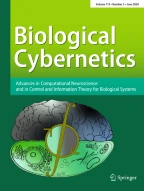Abstract
Rhythmic body motions observed in animal locomotion are known to be controlled by neuronal circuits called central pattern generators (CPGs). It appears that CPGs are energy efficient controllers that cooperate with biomechanical and environmental constraints through sensory feedback. In particular, the CPGs tend to induce rhythmic motion of the body at a natural frequency, i.e., the CPGs are entrained to a mechanical resonance by sensory feedback. The objective of this paper is to uncover the mechanism of entrainment resulting from the dynamic interaction of the CPG and mechanical system. We first develop multiple CPG models for the reciprocal inhibition oscillator (RIO) and examine through numerical experiments whether they can be entrained to a simple pendulum. This comparative study identifies the neuronal properties essential for the entrainment. We then analyze the simplest model that captures the essential dynamics via the method of harmonic balance. It is shown that robust entrainment results from a strong, positive-feedback coupling of a lightly damped mechanical system and the RIO consisting of neurons with the complete adaptation property
Similar content being viewed by others
References
Av-Ron E, Parnas H, Segel L (1993) A basic biophysical model for bursting neurons. Biol Cybern 69(1):87–95
Brown T (1911) The intrinsic factors in the act of progression in the mammal. Proc Roy Soc Lond B Biol Sci 84:308–319
Cohen A, Ermentrout G, Kiemel T, Kopell N, Sigvardt K, Williams T (1992) Modelling of intersegmental coordination in the lamprey central pattern generator for locomotion. Trends Neurosci 15(11):434–438
Doyle J, Packard A, Zhou K (1991) Review of LFTs, LMIs, and μ. In: Proceedings of IEEE conference on decision and control pp 1227–1232
Efimov D, Fradkov A (2004) Excitation of oscillations in nonlinear systems under static feedback. In: Proceedings of IEEE conference on decision and control pp 2521–2526
Ekeberg O (1993) A combined neuronal and mechanical model of fish swimming. Biol Cybern 69(5/6):363–374
Ermentrout G, Chow C (2002) Modeling neural oscillations. Physiol Behav 77:629–633
Ermentrout G, Kopell N (1984) Frequency plateaus in a chain of weakly coupled oscillators. I SIAM J Math Anal 15(2):215–237
Fradkov A (1979) Speed-gradient scheme and its application in adaptive control problems. Autom Remote Contr 40(9):1333–1342 (Translated from Avtomatika i Telemekhanika 9:90–101, 1979.)
Fradkov A (1999a) Exploiting nonlinearity by feedback. Physica D 128:159–168
Fradkov A (1999b) Feedback resonance in nonlinear oscillators. Proc Eur Contr Conf
Friesen W (1994) Reciprocal inhibition:A mechanism underlying oscillatory animal movements. Neurosci Biobehav Rev 18(4):547–553
Friesen W, Stent G (1978) Neural circuits for generating rhythmic movements. Annu Rev Biophys Bioeng 7:37–61
Fukuoka Y, Kimura H, Cohen A (2003) Adaptive dynamic walking of a quadruped robot on irregular terrain based on biological concepts. Int J Robot Res 22(3-4):187–202
Getting P (1989) Reconstruction of small neural networks. In: Koch C, Segev I (eds) Methods in Neuronal Modeling. MIT Press, Cambridge, pp 171–194
Glad T and Ljung L (2000) Control theory – multivariable and nonlinear methods. Taylor & Francis, Boca Raton, London
Hadeler K (1974) On the theory of lateral inhibition. Kybernetik 14:161–165
Hindmarsh J, Rose R (1982) A model of the nerve impulse using two first-order differential equations. Nature 296(5853):162–164
Hunt K, Sbarbaro D, Zbikowski R, Gawthrop P (1992) Neural networks for control systems – a survey. Automatica 28(6):1083–1112
Ijspeert A (2001) A connectionist central pattern generator for the aquatic and terrestrial gaits of a simulated salamander. Biol Cybern 84:331–348
Iwasaki T, Zheng M (2002) The Lur’e model for neuronal dynamics. In: Proceedings of IFAC world congress July 21–26, 2002, Barcelona, Spain
Khalil H (1996) Nonlinear systems. Prentice Hall, Englewood Cliffs
Lewis M, Etiennne-Cummings R, Hartmann M, Xu Z, Cohen A (2003) An in silico pattern generator:silicon oscillator, coupling, entrainment, and physical computation. Biol Cybern 88:137–151
Matsuoka K (1985) Sustained oscillations generated by mutually inhibiting neurons with adaptation. Biol Cybern 52:367–376
Matsuoka K (1987) Mechanisms of frequency and pattern control in the neural rhythm generators. Biol Cybern 56:345–353
Ogata K (1996) Modern control engineering. Prentice Hall, Englewood Cliffs
Ono K (1998) Self-excited natural periodical motion mechanism for efficient and robust locomotion. In: Proceedings of TITech COE/Super-Mechano Systems Workshop pp 32–43
Ono K, Takahashi R, Shimada T (2001) Self-excited walking of a biped mechanism. Int J Robot Res 20(12):953–966
Orlovsky G, Deliagina T, Grillner S (1999) Neuronal Control of Locomotion:From Mollusc to Man. Oxford University Press, Oxford
Raney D, Slominski E (2004) Mechanization and control concepts for biologically inspired micro air vehicles. J Aircr 41(6):1257–1265
Rinzel J (1985) Excitation dynamics:insights from simplified membrane models. Fed Proc 44(15):2944–2946
Taga G (1991) Self-organized control of bipedal locomotion by neural oscillators in unpredictable environment. Biol Cybern 65:147–159
Wadden T, Ekeberg O (1998) A neuro-mechanical model of legged locomotion:single leg control. Biol Cybern 79:161–173
Williamson M (1998) Neural control of rhythmic arm movements. Neural Netw 11:1379–1394
Author information
Authors and Affiliations
Corresponding author
Rights and permissions
About this article
Cite this article
Iwasaki, T., Zheng, M. Sensory Feedback Mechanism Underlying Entrainment of Central Pattern Generator to Mechanical Resonance. Biol Cybern 94, 245–261 (2006). https://doi.org/10.1007/s00422-005-0047-3
Received:
Accepted:
Published:
Issue Date:
DOI: https://doi.org/10.1007/s00422-005-0047-3
